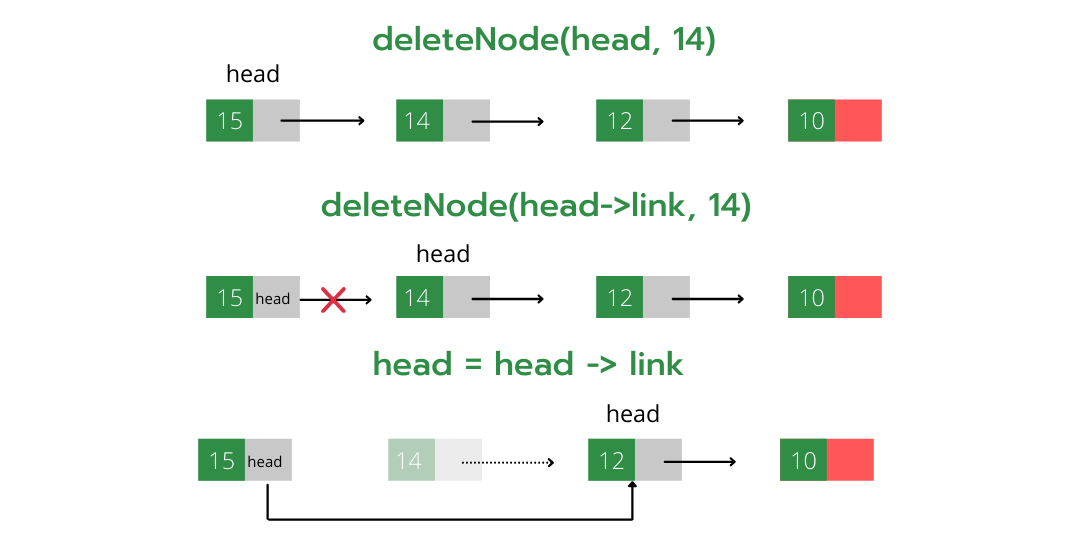C++程序 在链表中删除节点
让我们来制定一个问题陈述,以了解删除过程。 给定一个关键字,“删除”链表中第一个这个关键字的出现 。
迭代方法:
要从链表中删除一个节点,我们需要执行以下步骤。
1)找到要删除的节点的前一个节点。
2)更改前一个节点的下一个节点。
3)释放要删除的节点的内存。

// 一个完整的可运行的C++程序,
// 演示单链表中的删除
#include <iostream>
using namespace std;
struct node
{
int data;
node *next;
};
class linked_list
{
private:
node *head,*tail;
public:
linked_list()
{
head = NULL;
tail = NULL;
}
void add_node(int n)
{
node *tmp = new node;
tmp->data = n;
tmp->next = NULL;
if(head == NULL)
{
head = tmp;
tail = tmp;
}
else
{
tail->next = tmp;
tail = tail->next;
}
}
node* gethead()
{
return head;
}
static void display(node *head)
{
if(head == NULL)
{
cout << "NULL" << endl;
}
else
{
cout << head->data << endl;
display(head->next);
}
}
static void concatenate(node *a,node *b)
{
if( a != NULL && b!= NULL )
{
if (a->next == NULL)
a->next = b;
else
concatenate(a->next,b);
}
else
{
cout << "Either a or b is NULL\n";
}
}
void front(int n)
{
node *tmp = new node;
tmp -> data = n;
tmp -> next = head;
head = tmp;
}
void after(node *a, int value)
{
node* p = new node;
p->data = value;
p->next = a->next;
a->next = p;
}
void del (node *before_del)
{
node* temp;
temp = before_del->next;
before_del->next = temp->next;
delete temp;
}
};
int main()
{
linked_list a;
a.add_node(1);
a.add_node(2);
a.front(3);
a.add_node(5);
a.add_node(15);
a.after(a.gethead()->next->next->next, 10);
a.del(a.gethead()->next);
linked_list::display(a.gethead());
return 0;
}
输出
3
1
5
10
15
NULL
时间复杂度: O(n),其中n表示给定链表的长度。
辅助空间: O(1),不需要额外空间,因此是一个常数。
递归方法:
为了递归地删除链表的一个节点,我们需要执行以下步骤。
1.我们将node*(节点指针)作为函数的引用传递(如node* &head)。
2.现在,由于当前节点指针是从前一个节点的next派生的(它通过引用传递),因此现在如果当前节点指针的值已更改,则前一个next节点的值也会发生更改,这是删除节点所需的操作(即使前一个节点的下一个指向当前节点,包含关键字的下一个指向)。
3.查找包含给定值的节点。
4.存储此节点以稍后使用free()函数进行解除分配。
5. 改变该节点指针,使其指向其下一个节点,并通过此操作将上一个节点的下一个节点正确链接。

以下是上述方法的实现。
// C++递归删除单链表中的节点程序
#include <iostream>
// 节点结构
struct node{
int data;
struct node* next;
node(int val){
data = val;
next = NULL;
}
};
/*删除单链表的函数。我们将通过引用方式将head作为参数传递到函数中,
因为我们想要在从递归返回后永久将head的值设置为NULL*/
void delete_a_linked_list(struct node*& head){
if(head == NULL){ // 到达链表尾部,返回!!
return;
}
delete_a_linked_list(head->next);// 调用递归,精确到尾递归(tail recursion)
std::cout<<"删除节点"<<head->data<<"\n"; // 在删除之前打印节点值
free(head); // 从内存中释放节点,然后返回
head = NULL; // 将指针指向NULL。
}
int main() {
// 创建一个测试链表
// 2->4->6->9->NULL
struct node* head = new node(2);
head->next = new node(4);
head->next->next = new node(6);
head->next->next->next = new node(9);
// 调用函数
delete_a_linked_list(head);
if(head == NULL){
std::cout<<"链表为空\n";
}else{
std::cout<<"链表不为空\n";
}
return 0;
}
输出
删除节点9
删除节点6
删除节点4
删除节点2
The Linked List is empty
时间复杂度: O(n),其中n表示给定链表的长度。
辅助空间: O(n),由于递归调用栈,其中n表示给定链表的长度。
 极客教程
极客教程